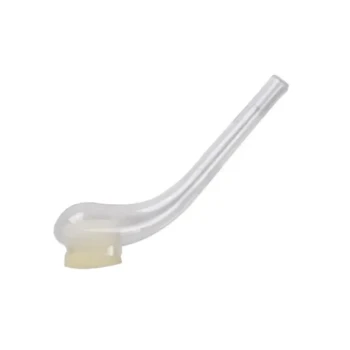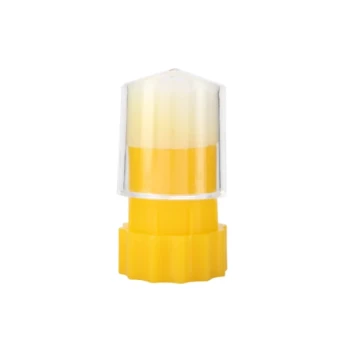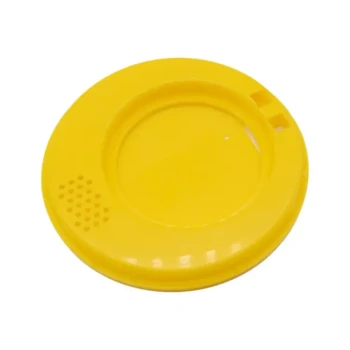Ultimately, the success of honey bee artificial insemination is evaluated by how quickly the inseminated queen begins to lay eggs (oviposition). This is the primary and most immediate indicator, with modern, proficient techniques yielding results that are comparable to those of naturally mated queens.
Evaluating artificial insemination goes beyond a single metric. True success lies in producing a queen with high, long-term reproductive potential, a factor determined not only by the insemination procedure itself but also by the biological quality of the queen from her earliest larval stage.
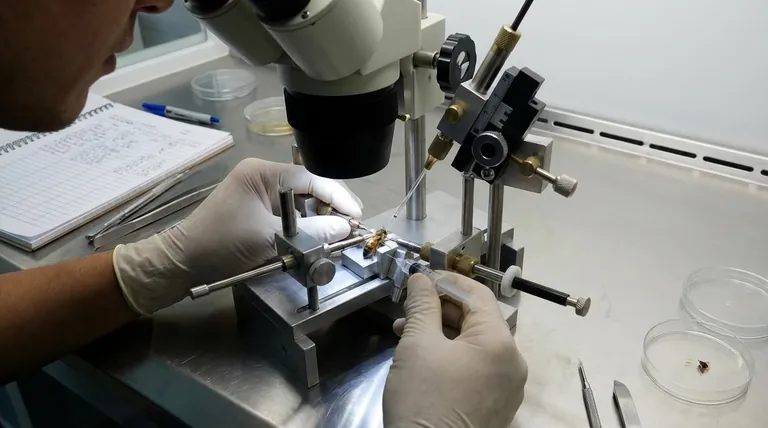
The Purpose of Instrumental Insemination
Instrumental insemination is a powerful tool for honey bee breeders. Its primary purpose is not just to get a queen mated, but to achieve complete control over the colony's genetics.
Controlling Genetic Lines
Natural mating is unpredictable. A virgin queen flies out and mates with multiple drones from various colonies, mixing genetics randomly.
In contrast, instrumental insemination allows a breeder to select both the queen (maternal line) and the specific drones (paternal line). This precision is essential for propagating desirable traits like disease resistance, gentleness, or honey production.
Ensuring a Well-Mated Queen
The technique allows for the delivery of a known, sufficient quantity of semen. This helps ensure the queen has enough sperm to fertilize eggs for her entire productive lifespan, which can be several years.
Primary Metrics for Evaluating Success
While several factors contribute to a successful outcome, they are measured in a few key ways.
Time to Onset of Oviposition
This is the most common and immediate measurement of success. After insemination, a well-mated queen should begin laying eggs in a timeframe similar to a naturally mated one. A significant delay can indicate a problem with the procedure or the queen's health.
Long-Term Reproductive Capacity
A truly successful insemination results in a queen who is not just laying, but is highly productive over the long term. This is a function of her internal anatomy.
Key indicators of high capacity include a large spermathecal volume (the organ that stores sperm) and large ovary size. These traits are not determined by the insemination itself, but by the quality of the queen's rearing.
Key Factors That Influence the Outcome
Success is not guaranteed. It is the result of controlling several critical variables before and during the procedure.
The Quality of the Queen
You cannot fix a poorly-reared queen with perfect insemination. The queen's ultimate reproductive potential is set during her larval stage.
Queens reared from younger larvae (ideally 0-24 hours post-hatch) develop larger, more robust reproductive systems. This is the foundation of a successful outcome.
The Insemination Technique
The physical process requires specialized equipment, a steady hand, and extensive practice. Semen is collected from drones using a capillary tube and then carefully injected into the median oviduct of an anesthetized queen.
Poor technique can injure the queen, introduce infection, or fail to deliver the semen to the correct location, rendering the attempt a failure.
Understanding the Trade-offs and Challenges
While powerful, instrumental insemination is not without its difficulties and requires a clear understanding of its limitations.
The High Skill Barrier
This is not a technique for beginners. Mastering the procedure to avoid injuring the queen and achieve a high success rate requires significant training and practice. The investment in both time and specialized equipment is substantial.
Queen Rearing is Foundational
A common pitfall is focusing solely on the insemination process while neglecting the fundamentals of queen rearing. An insemination can only be as successful as the biological potential of the queen allows. A queen with underdeveloped ovaries will never be a prolific layer, no matter how perfectly she is inseminated.
Genetic Control vs. Diversity
The precision of instrumental insemination is its greatest strength for selective breeding. However, in a natural setting, a queen mating with 15-20 different drones provides a high degree of genetic diversity within the colony, which can enhance its resilience. Breeders using insemination must manage their programs carefully to maintain sufficient genetic diversity across their entire stock.
Making the Right Choice for Your Goal
Your evaluation of success should align directly with your breeding objectives.
- If your primary focus is rapid colony expansion: The speed of oviposition onset is your most critical short-term metric.
- If your primary focus is long-term genetic improvement: You must look beyond egg-laying and consider the foundational quality of the queen, which begins with proper rearing from the youngest possible larvae.
- If you are implementing an insemination program: Your first measure of success is proficiency, defined by a high rate of queen survival and successful insemination without injury.
Understanding these interconnected factors is the key to achieving predictable and successful honey bee breeding outcomes.
Summary Table:
| Metric | Description | Why It Matters |
|---|---|---|
| Time to Oviposition | How quickly the queen begins laying eggs after insemination. | Primary indicator of a successful procedure; delays suggest issues. |
| Long-Term Reproductive Capacity | The queen's sustained egg-laying ability over her lifespan. | Determined by queen quality (spermathecal volume, ovary size). |
| Queen Survival Rate | Percentage of queens that survive the insemination process without injury. | A key measure of the breeder's technical skill and proficiency. |
| Genetic Control | Precision in selecting maternal and paternal lines for specific traits. | The core purpose of AI for targeted genetic improvement programs. |
Ready to Elevate Your Beekeeping Operation?
Achieving consistent success in honey bee breeding requires not just skill but also the highest-quality equipment. HONESTBEE supplies commercial apiaries and beekeeping equipment distributors with the durable, precision tools needed for advanced practices like instrumental insemination and superior queen rearing.
Let us help you build a more productive and genetically resilient apiary.
Contact HONESTBEE today to discuss your wholesale equipment needs and breeding goals.
Visual Guide
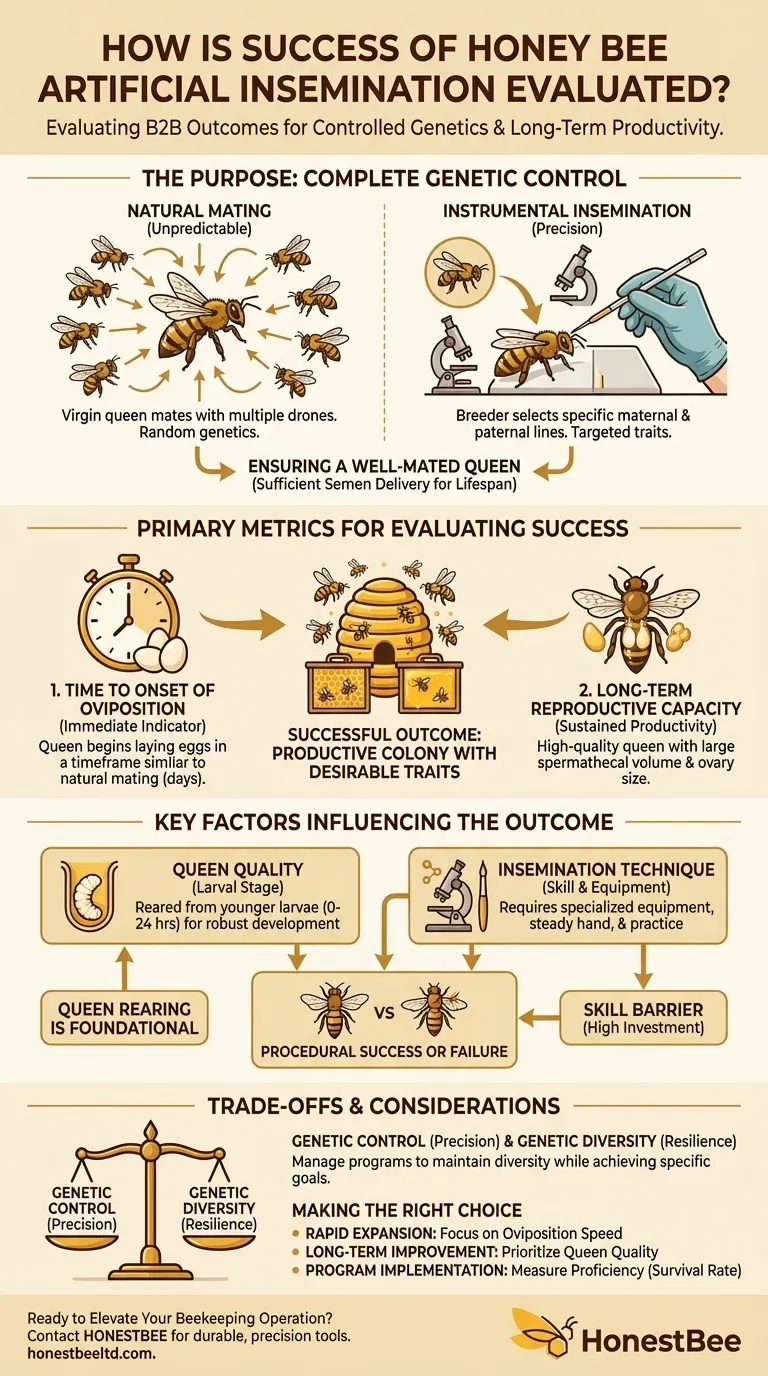
Related Products
- Queen Bee Artificial Insemination Instrument Equipment for Instrumental Insemination
- Plastic Chinese Queen Grafting Tool for Bee Queen Rearing
- Plastic Long Marker Device for Catching and Marking Bees Queen Bee Marking Tube and Cage
- Professional Queen Catcher and Introduction Queen Cage
- Wooden Queen Bee Excluder for Beekeeping
People Also Ask
- What are the methods for controlling honey bee mating? Mastering Genetic Selection for Your Apiary
- What is the typical semen yield from a single honey bee drone? A Key Metric for Successful Queen Insemination
- What techniques have been used for semen mixing in artificial insemination? Master the Standard Protocol for Genetic Diversity
- How long does it take to master instrumental insemination? A 2-Year Journey to Queen Rearing Proficiency
- What is instrumental insemination's role in bee breeding? Master Genetic Control for Superior Honey Bees



